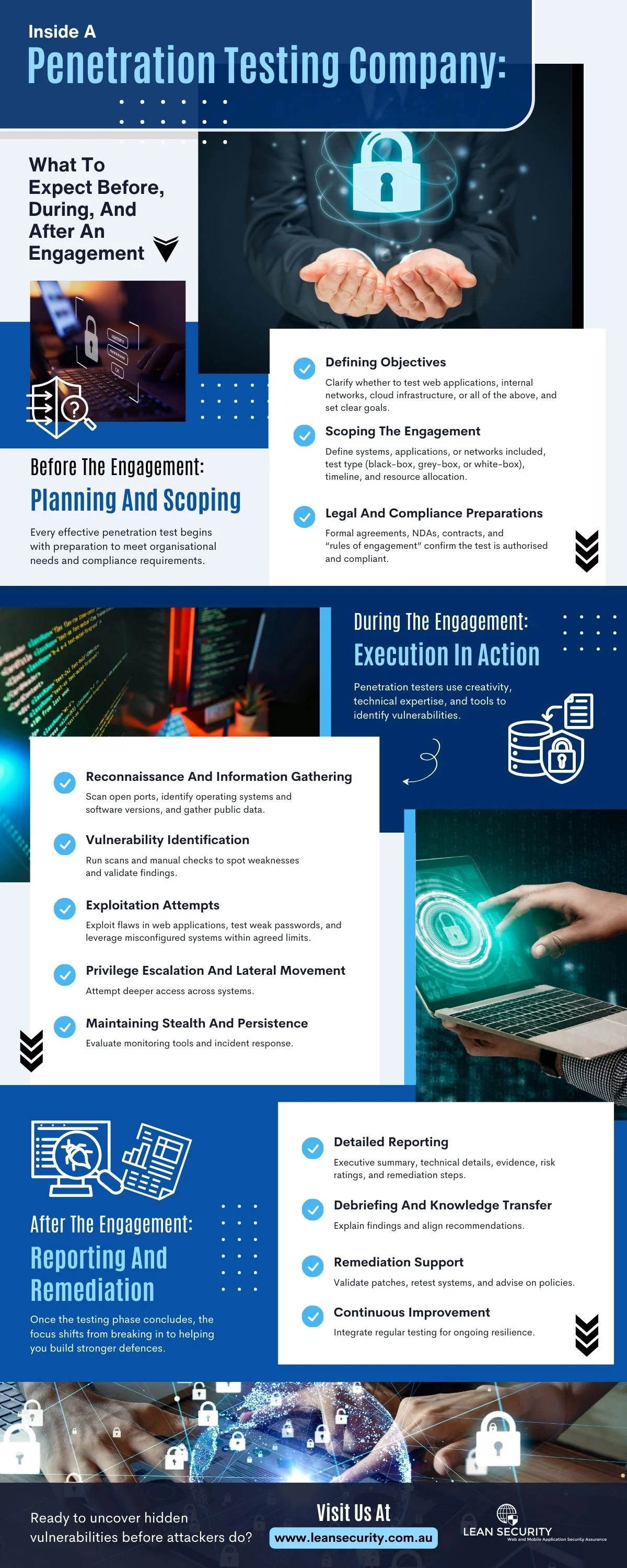When it comes to enhancing cybersecurity, penetration testing isn’t just a checkbox — it’s a critical process that reveals how secure your digital environment really is. Many businesses know the term “pen test,” but few understand what actually goes on behind the scenes at a penetration testing company.
So, what should you expect when you partner with a penetration testing provider? Let’s break down the process step by step, before, during, and after the engagement, so you know exactly how these companies work to safeguard your systems.
Before the Engagement: Planning and Scoping
Every effective penetration test begins with preparation. This stage ensures the engagement aligns with your organisation’s needs and compliance requirements.
1. Defining Objectives
The company will work closely with you to clarify the goals of the test. Do you want to test your web applications, internal network, cloud infrastructure, or all of the above? Are you aiming for compliance or strengthening defences proactively? Clear objectives drive the scope.
2. Scoping the Engagement
A detailed scope ensures the test targets relevant systems without disrupting business operations. Expect to define:
· The systems, applications, or networks included
· Whether the test will be black-box (no prior knowledge), grey-box (partial knowledge), or white-box (full access)
· Timeline and resource allocation

3. Legal and Compliance Preparations
Penetration testing requires formal agreements to avoid misunderstandings. Non-disclosure agreements (NDAs), contracts, and “rules of engagement” documents protect both the company and the client. This step confirms the test is authorised and compliant with regulatory standards.
During the Engagement: Execution in Action
This is where the real work begins. Penetration testers combine creativity, technical expertise, and industry tools to identify vulnerabilities just as an attacker would.
4. Reconnaissance and Information Gathering
Pen testers start by collecting as much information as possible. This may include:
· Scanning open ports
· Identifying operating systems and software versions
· Gathering publicly available data
Recon is about mapping the attack surface before attempting to breach it.
5. Vulnerability Identification
Next, testers run scans and manual checks to spot weaknesses. Automated tools flag potential issues, but skilled testers validate findings to avoid false positives.
6. Exploitation Attempts
Here’s where the engagement gets interesting. Testers attempt to exploit vulnerabilities to gain access. This may involve:
· Exploiting web application flaws (SQL injection, XSS, and authentication bypass)
· Testing weak password policies
· Leveraging misconfigured systems
While real-world attack techniques are used, testers operate within agreed boundaries to prevent actual damage.

7. Privilege Escalation and Lateral Movement
If access is achieved, testers often attempt to escalate privileges or move laterally across systems. This demonstrates how an attacker could deepen their control within your environment.
8. Maintaining Stealth and Persistence
Some engagements include testing whether attackers could remain undetected. This evaluates monitoring tools, intrusion detection systems, and incident response capabilities.
After the Engagement: Reporting and Remediation
Once the testing phase concludes, the focus shifts from breaking in to helping you build stronger defences.
9. Detailed Reporting
Expect a comprehensive report that includes:
· Executive summary for leadership teams
· Technical details for IT staff
· Evidence of exploited vulnerabilities
· Risk ratings for each issue
· Actionable remediation steps
The best penetration testing companies translate complex technical findings into clear, prioritised insights for decision-makers.
10. Debriefing and Knowledge Transfer
A good provider doesn’t just hand you a report and walk away. They schedule a debriefing session to explain findings, answer questions, and align recommendations with your business context.
11. Remediation Support
After identifying weaknesses, companies often support remediation efforts. This could mean validating patches, retesting systems, or advising on security policies. The goal is to ensure fixes are not only applied but also effective.

12. Continuous Improvement
Penetration testing isn’t a one-time exercise. Leading companies encourage clients to integrate regular testing into their security strategy, aligning with compliance requirements (like PCI DSS or ISO 27001) and evolving cyber threats.
Behind the Scenes: What Sets Penetration Testing Companies Apart
Not all penetration testing providers are the same. Here are qualities that separate the best from the rest:
Expertise Beyond Tools: While automated tools help, skilled testers rely on creativity, experience, and human insight.
Industry-Specific Knowledge: Financial, healthcare, and retail sectors face different risks. Specialised knowledge ensures testing is relevant.
Clear Communication: The best firms simplify technical details, making results actionable for executives and IT teams alike.
Adaptability: Cyber threats evolve quickly. Strong companies continuously update methodologies to mimic current attack techniques.
Why This Process Matters
Understanding what happens before, during, and after a penetration test gives you confidence in the process. It also highlights why working with an experienced penetration testing company is so valuable: they don’t just find vulnerabilities; they help you close them and strengthen your overall security posture.
The Role of Collaboration Between Client and Tester
Penetration testing is not a one-sided effort. While the testers bring technical expertise and attacker-like creativity, the client’s role is equally important in shaping the outcome. Effective collaboration begins during the scoping stage and continues throughout the engagement. Your IT and security teams provide valuable insights into business priorities, critical systems, and operational concerns that help testers focus their efforts.
Clear communication also ensures the testing process doesn’t disrupt normal business operations. For example, scheduling tests during off-peak hours or identifying systems that cannot be interrupted minimises operational risks. When clients and testers work hand in hand, the results are not only more accurate but also more relevant to the organisation’s unique environment.
Turning Insights Into Long-Term Security Strategy
The end of a penetration test should mark the beginning of a stronger security journey. Too often, organisations view the final report as a checklist of fixes. In reality, the findings provide a roadmap for building long-term resilience.
By analysing recurring vulnerabilities and common weaknesses, businesses can identify patterns that point to deeper issues, such as insufficient staff training, outdated patching processes, or weak access controls. Penetration testing companies often highlight these themes and advise on preventative measures that go beyond immediate remediation.
When leveraged strategically, penetration test insights can influence policy decisions, guide investments in new technologies, and strengthen incident response readiness. Instead of reacting to individual vulnerabilities, organisations build a proactive security culture that evolves with the threat landscape.
Leading Penetration Testing Company
At Lean Security, we believe penetration testing should be more than a technical exercise — it should empower your business with clarity, protection, and confidence. Our expert team guides you through every stage of the process, from vulnerability scanning to web application security, ensuring your systems are tested against real-world attack techniques without unnecessary disruption.
Whether you’re preparing for compliance, defending sensitive data, or strengthening customer trust, Lean Security delivers results that go beyond reports. Don’t leave your organisation exposed to unknown risks. Partner with Lean Security today and take proactive steps toward a more resilient security posture.
Reach out now.


